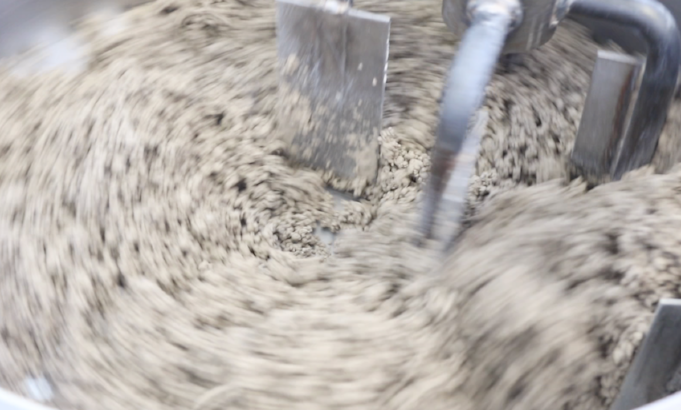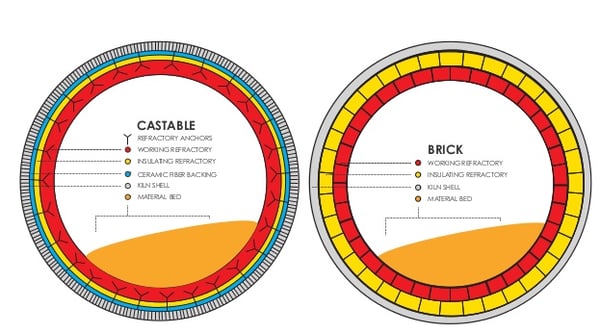
Monolithic refractories have developed over the years to become what they are today. This technical blog post will talk specifically about castables, gunning mixes and dry vibratables and how they have evolved.
castables
A significant development in monolithic technology was the development of refractory concretes or castables based on calcium alumina cements (CACs): from conventional castables (CaO>2.5%), to low cement castables (LCCs; 2.5%>CaO>1.0%), to ultra-low cement castables (ULCCs; 1.0%>CaO>0.2%) to cement-free castables (CaO<0.2%), the CaO content of the monolithic material is reduced, in order to improve its high temperature properties, through which the temperature at which it can be used is increased. Conventional castables require 8–15% water addition. The added water is taken up by the porosity of the grain, required for the hydraulic bond, and is required for the concrete to flow. Compared with brick that is based on the same raw materials, the concrete has the disadvantages of higher porosity, higher concentration of fluxes (CaO, Fe2O3), and low hot strength. The fluxes affect the corrosion resistance and hot strength negatively, while phase transformations associated with the dehydration process lead to a reduction in mechanical strength in the 538–982°C temperature range. Castables with low cement contents, in which part of the cement content was replaced by fine particles (1–10 μm) or additives, were first referred to in a French patent in 1969. The crucial step was to use ultrafine particles ≤ 1 μm. These materials should be inert to hydration and should not form gels with water. The fine particles subsequently fill the voids between the coarse grains, which reduces water consumption, and therefore the porosity, and increases the strength of the material. Long drying periods are consequently required to avoid cracking and spalling. Submicrometer powders commonly used in low cement (LC, containing 4–8% calcium alumina cement) and ultra-low cement (ULC, containing 1–2% calcium alumina cement) castables include microsilica (obtained from SiO2-rich fume produced from the smelting of ferrosilicon and silicon metal, with an average particle diameter of ~15 mm) and Al2O3. Microsilica not only acts as a filler, but also reacts with the calcium aluminate phases in the cement and water to form zeolithic CASH phases. The chemically bonded water is subsequently not released abruptly, but progressively over a wide temperature range.
One major problem still remained with low-cement castables: reaction between the reactive silica and calcium aluminate cement resulted in the formation of low-melting phases such as anorthite (CaO.Al2O3.2SiO2) and gehlinite (2CaO.Al2O3.SiO2), as the CaO content in LCC varies between 1.0-2.5%. The formation of viscous liquids at 1400°C and above contributes to the loss of strength of the castable. This can be avoided by replacing the microsilica with superfine Cr2O3 or superground calcined alumina, although the addition of chromium oxide is environmentally unacceptable in many countries. Conventional castables are installed by pouring, while flow and compaction of LCCs and ULCCs are usually promoted by internal or external vibration after pouring, since these materials are thixotropic in nature. Application of vibration can obviously cause problems as too little vibration causes lack of consolidation and compaction, while too much vibration causes segregation. In an attempt to overcome the difficulties associated with vibration placement, a new class of LCCs and ULCCs was developed in the mid-1980s: the free or self-flowing castables (SFCs), which are sol-gel bonded castables or pumpables, have a modified rheology of the LCC and ULCC systems as a result of changing the shape and size distribution of the aggregates and a well-considered choice of deflocculants. Colloidal silica is used as the main source in gel-bond technology. The colloid is gelled around the refractory particles, and after drying forms a gel skeleton that provides strength to the refractory. The gel skeleton is highly reactive and forms mullite with fine alumina at relatively low temperatures. The gel-bond castables are more thermally stable and have higher thermal shock resistance, higher HMOR and refractoriness than cement-containing castables. These are castables with a consistency after mixing that allows them to flow and degas without the application of external energy. The development of the SFCs led to the development of a new placement technique called wet gunning or shotcreting . The first results on wet gunning of castables were published in 1963, but only in 1991 did it become an effective installation tool.
Other types of castables include insulating castables (which can be poured or gunned into position), conventional basic castables (which are mostly used for repair) as well as alumina-spinel and alumina-magnesia castables. The steel industry was also the driving industry for the development of alumina-spinel and alumina-magnesia castables. Spinels used in castables are either of stoichiometric composition or in the high alumina composition range, as magnesia-rich compositions create problems of hydration of the magnesia. Spinel-reinforced or spinel-added castables (fine spinel grains added to the matrix), and spinel-forming castables have gained popularity.

Gunning mixes
Gunning mixes can be installed quickly and are mostly used as a repair material. Installation involves the transport of dry or semidry materials pneumatically by compressed air, with water addition at the nozzle. Gunning mixes can be lightweight for insulation or dense for more severe conditions, and can be used with different binders, depending on the application. These binders include clays, colloidal silica, dry phosphates, calcium alumina cements and organic compounds, such as molasses, lignosulphonates and synthetic resins.
Dry vibratables
Dry vibratables were developed during the late 1970s and early 1980s. The significant advantage of a dry vibratable is that it can be used soon after being installed. Since dry vibratables contain no liquids, slow or prolonged heating is not required to avoid cracking or spalling. Dry mixes are placed in the dry state by either vibration or ramming. Through their carefully designed particle size distribution they reach maximum compaction without the addition of liquids. The grain size distribution is therefore key in obtaining a dense and strong dry vibratable. The grains should be in close proximity to have the most effective solid-solid reaction. Small quantities of low-melting components form the initial bond at 400–600°C, while high-temperature ceramic bonding is achieved above 1200–1300°C. The formulation should therefore be such that the low-melting phases should react at high temperatures to form highly refractory phases. The dry vibratables may have a temporary bond (organic additives, sintering agents) but are eventually ceramics bonded through an increase in temperature.
If you have any question about monolithic refractories, optimizing production or just a general question on refractories, don’t hesitate to ask us! We will be glad to talk with you and discuss further any topic.





